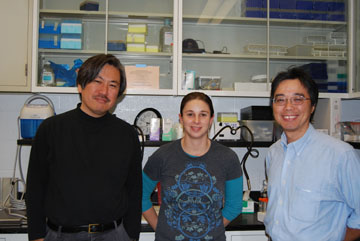Special Research Issue: Saito Lab Investigations Provide Insight into New Risks Involving Aging, Fat Tissue
A new lab in the surgery department headed by Hiroshi Saito, PhD is investigating and discovering important clues to the effects of aging on sepsis and systemic inflammation. The lab has numerous studies funded by prestigious organizations such as the National Institute on Aging and the National Institutes of Health. Working with Dr. Saito are Hitoshi Takahashi, PhD and Marlene Starr, a third year graduate student in molecular biology. The lab is one of a number that came from Texas with Dr. B. Mark Evers, Director of the Markey Cancer Center. The Saito lab has origins at the University of Texas Medical Branch in Galveston, Texas.
Background
Sepsis and systemic inflammatory response syndrome (SIRS) affect nearly 700,000 people annually in the US and these conditions are the 10th leading cause of death in the population over 65 years of age. Moreover, these diseases are the second leading cause of death in the intensive care unit. SIRS is an uncontrolled immune response to trauma, burns or complications from major surgery. When accompanied by an infection, the term is sepsis. These diseases frequently strike patients who already are very ill and are hospitalized, for example, for organ transplant or severe burns. These patients’ conditions are typically managed with IVs, surgical catheters and other forms of life support.
Sepsis/SIRS leads to increased blood clots, vasodilation (widening of the blood vessels) which causes hypertension, septic shock, organ failure and ultimately death. Although current medicine is more successful in treating SIRS/sepsis in young patients, the same treatments are not effective in the elderly. This supports the Saito lab’s hypothesis that independent mechanisms regulate inflammatory processes in aging.
On the cellular level, the production of interleukin-6 (IL-6) is augmented during SIRS and sepsis. In recent studies, the Saito lab discovered that of all the tissues in the body, fat tissue (adipose) expresses the highest level of IL-6 and this expression is more than double in an aged population. In a subsequent study, the lab examined events upstream of IL-6 and found that IL-6 production in fat tissues is induced by IL-1β which is expressed primarily in the lungs and spleen. Their studies suggest that these processes are augmented in the aged, which contributes to increased susceptibility of the aged to sepsis/SIRS.
Another project by the Saito lab involves investigating coagulation differences in the young and aged. They recently found that a major anticoagulant mechanism, the Protein C Pathway, is suppressed by aging. This suppression results in increased coagulation in the aged which is mediated by a decrease in the anti-coagulant protein, thrombomodulin, one of the main activators of Protein C. These studies suggest that age-associated increases in disseminated intravascular coagulation during systemic inflammation are a result of protein C pathway suppression.
In conclusion, these important studies show that independent mechanisms exist to regulate inflammatory and coagulant processes in the aged and that adipose (fat) tissue is very much involved in the inflammatory response. A greater understanding of the disease process of sepsis and SIRS will ultimately lead to new and better treatments, particularly for the elderly population.
